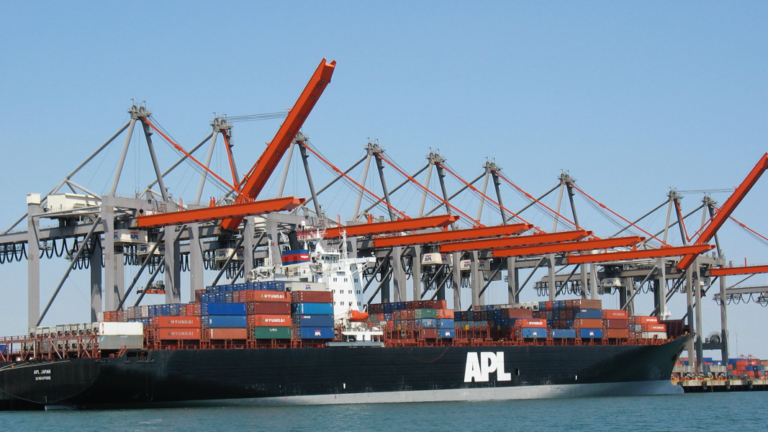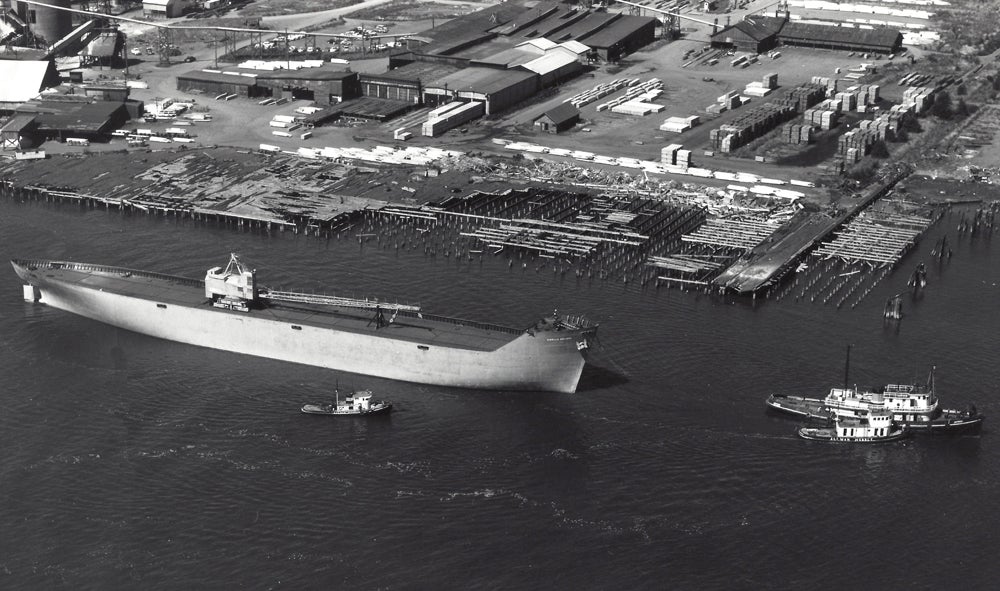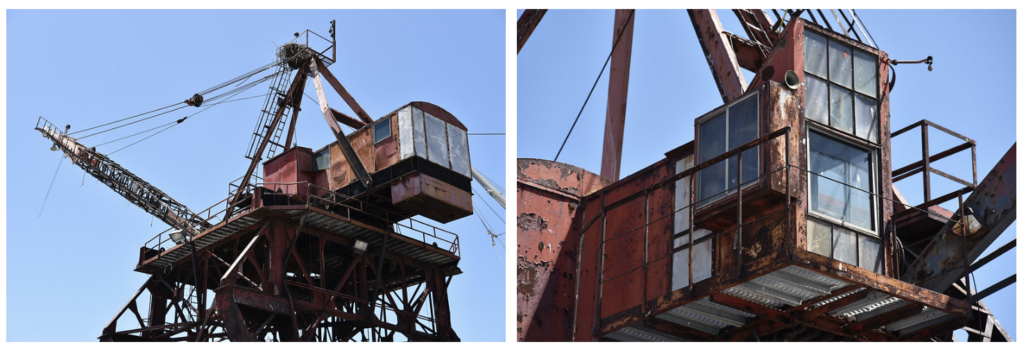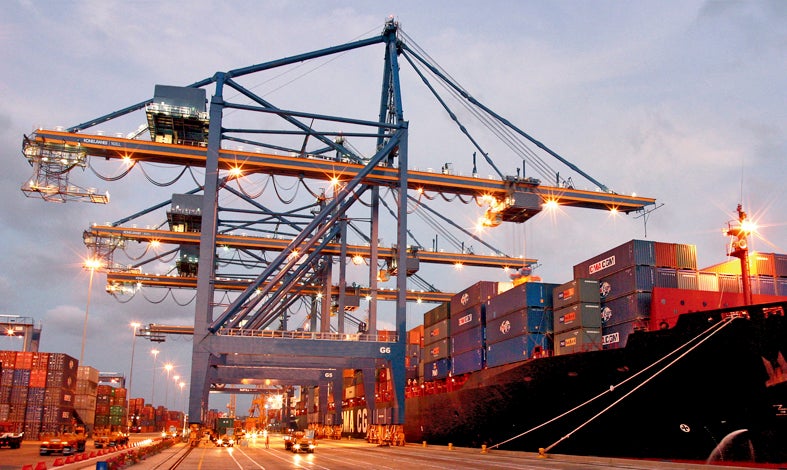
Container cranes working on an APL cargo ship. Source: James A. Fawcett
14. Container Cranes: Linking Ship to Shore
Author: Dr. James A. Fawcett, USC Sea Grant Maritime Policy Specialist/Extension Director (retired)
Media Contact: Leah Shore / lshore@usc.edu / (213)-740-1960
Cranes (in the family Gruidae) are birds characterized by long legs, long necks, upright posture, and the ability to fly long distances. They are among the tallest flying birds and are as elegant on the ground near water as in the air.[1] It seems appropriate then that we use the same term—crane—for the massive, tall, upright arching, metal container cranes that also reside by the water, moving intermodal freight containers between the dock and adjacent ships These ship-to-shore cranes were a brilliant innovation that made cargo containerization feasible in the late 1950s and revolutionized the efficiency of the movement of goods around the world.
The Birth of the Container
Looking back almost 70 years, Malcolm McLean’s innovation to pack cargo into containers (often referred to on the docks as “cans” or “boxes’) and ship the container as a unit on board ship birthed both an economic as well as physical transformation in the movement of goods by sea. As reported by Marc Levinson, loading loose cargo on a medium-size cargo ship cost $5.83 per ton in 1956. McLean’s experts pegged the cost of loading the Ideal X [the first ship that McLean converted to transport containers] at 15.8 cents per ton. With numbers like that the container seemed to have a future.”[2] Further, the advantage could be multiplied if those same containers could be quickly and efficiently transferred from ship to shore, a challenge not yet met in 1956 when the Ideal X made its first trip on April 26 from Newark, New Jersey carrying 58 trailers [not yet called containers] to Houston, Texas.[3]
McLean’s original “trailers” were 33 feet long by 8 feet wide and 8½ feet high. The choice of size was his alone since he designed the system; however, in 1956 it clearly was not yet a system but rather an interesting innovation in the well-established shipping industry. When ordering the first tranche of containers from Brown Trailer Co. in Toledo, Ohio, he also secured an even bigger prize by convincing Brown’s Vice President of Engineering, Keith Tantlinger, to become his vice-president of engineering at his two steamship companies, Waterman Steamship Corporation and Pan-Atlantic Steamship Corporation. Tantlinger and his team of engineers became the key link in transforming a brilliant idea into a true system by designing innovation after innovation to facilitate the entire vessel containerization system.[4]
Bringing a new technology, especially one that would challenge the accustomed prerogatives of a large contingent of labor, would not be easy, as Levinson notes, it was only because of McLean’s determination as well as his political skill as the owner of a large trucking company that the industry would listen to his idea. Moreover, even the technology was not yet completely devised, especially the means by which containers would be loaded and unloaded from a ship designed to carry them.
Whirley Cranes: The Original Prototype
Instead of a “piggyback” service where roadway trailers would be merely lifted onto the ship’s deck, McLean’s idea was to separate the container from the underlying wheels so that the containers could be stacked on the ship’s deck. The ability to stack containers was critical to the efficiency and capacity of such a system but somehow the containers needed a device—a wheeled chassis—to support the containers when unloaded for roadway transit. With that issue resolved, the focus shifted to the dock where containers were delivered for transfer to the awaiting vessel.
In the earliest days, boxes were lifted one at a time by a truck-mounted moveable crane, one much like we see frequently at construction sites. But these cranes were merely an adaptation of existing construction equipment and hardly met the needs of new, faster technology. As the Waterman and Pan-Atlantic container fleet grew, it found dock space where track mounted revolving (or “whirley”) cranes were available to transfer the cargo. But this was still a transitional arrangement that needed further refinement both for speed and efficiency.
An essential element for moving the containers was the “spreader”, essentially a steel frame the same length and width as the container, with curved bars at each corner to attach to the top of the box, to permit it to be lifted into place. Needing further refinement, Tantlinger patented the “twistlock” system that is still used to secure the spreader to the box for transfer and when transferred to the ship from the box to containers both above and beneath it when stacked.[5]

Ship-to-Shore Refinements
The major issue with this early crane system was that the cranes were not big enough to reach all parts of the ship from one docking position, making it necessary to either move the ship or the cranes to load both the forward and aft decks. Acknowledging this major issue in efficiency for his new East Coast technology, McLean consulted an unusual source, the Skagit Steel and Iron Works in Sedro-Woolley, Washington, a firm that had considerable expertise in designing and building cranes for the logging industry. Despite his unfamiliarity with electric cranes (logging cranes were diesel-driven), the owner agreed to build a gantry-style crane that would ride on rails along the dock and allow a long gantry to extend from the dock over the beam of the entire ship. This, in turn, would allow a box to be lifted from the dock, raised 90 feet, moved to any position on the width of the ship, and then lowered into place as directed by a longshoreman on deck. This crane solves the issue by providing successful ship-to-shore (STS) movement. In 90 days, Skagit had designed and built a prototype.[6]
Evolving Containerization Across the Nation
While McLean evolved his new technology on the East Coast with his Pan-Atlantic Steamship Company (renamed Sea-Land Service, Inc. in 1960), on the West Coast, the Matson Navigation, Inc., a steamship line that specialized in providing regular freight service between California and Hawai’i also explored containerization. Matson established a standard size for its containers at 20 feet long by 8 feet wide and 8 feet tall. However, it, too, faced the problem of inefficient S-T-S movement of boxes. Based on work by the Matson engineering staff, Matson engaged the Pacific Coast Engineering Company in Oakland, California to build a gantry crane that would reach from shore to the farthest spot on the opposite side of the ship and would have the capacity to lift a fully-loaded 40-ton container.[7] The crane was installed at the Encinal Terminal at Alameda and initiated service in early 1959, serving until it was sold in 1987 to the Port of Nanjing. However, as is common with new technologies, and especially those requiring significant capital and design changes from heretofore standard operating procedures, the containerized business flagged in the early 1960s up until they were needed in wartime for optimal performance. Thus, in time between Sea-Land and Matson, containerization became gradually systematized.
A Wartime Paradigm Shift
The innovations brought by this new system resulted in rapid loading and unloading of cargo and faster delivery of goods to the end-user, features especially needed by the military in times of war. And the war that brought its wider use came about in the mid-1960s in Southeast Asia where rapid delivery of war matériel was needed on an ongoing basis. By 1967, Sea-Land had contracted to provide a full range of container services to the huge logistics base at Cam Ranh Bay, Vietnam (as well as a smaller operation at Danang) that included the installation of container cranes built on-site at Cam Ranh. Vietnam provided the “proof of concept,” so, by the early 1970s, other carriers realized that they could move vast amounts of cargo more cheaply and rapidly than by the older break-bulk system of individual crates, pallets, and boxes.
The change to containerization in maritime goods movement is analogous to the notion of “paradigm shift” in scientific revolutions[8]. Here it required not only that ship design be greatly modified, but also that seaports concurrently be modified to take advantage of this new technology. Among the many changes including from rail connections, roadways, and newly designed container terminals, docks needed to be modified by installing huge container cranes to load and unload the boxes. Absent these changes, ports were not able to take advantage of the revolution.

Modern-Day Cranes
Container cranes in 2021 generally come in three sizes: Panamax, post-Panamax, and Super-post-Panamax sizes, each referring to the size of the vessel being served. Panamax vessels must have a beam (width) not more than 106 feet so that they can pass through the original locks of the Panama Canal. Post-Panamax refers to the beam of not more than 161 feet, permitting passage through the locks of the New Panama Canal, which opened in 2018. Super-post-Panamax (also known as Megamax) vessels are no wider than 202 feet. In operation, at least three criteria must be met for each crane: 1) the gantry on each crane when deployed to its horizontal position must be higher than the anticipated stack of containers on a loaded ship; 2), the gantry must be able to reach to the last container on the stack most distant from the crane; and 3), the crane must be able to lift a 40 tonne[9] box in that last position. Cranes are generally supported on rails permanently installed on the dock, which permit the cranes to move laterally to match the stack of containers on which it is working, although there are situations where smaller cranes are supported by rubber tires. Commonly, there can be as many as five gantry cranes working on a large vessel, each working with a team on the dock. The number and location of cranes is determined by the location and number of boxes to be transferred.

The Ports of Los Angeles and Long Beach use what are called S-T-S quayside gantry cranes, a style of crane referred to as a “hammerhead” crane.[10] In this design, the crane operator sits in a cab on the “trolley,” the moveable part of the crane that slides along the gantry, hovering over the box to be moved. Thus the crane operator views the box to be transferred through a glass window in the floor of the cab, and as the trolley slides back and forth between the dock and the ship, the cab is always above the container being moved. The crane operator is advised as to the location for the box on the vessel by the foreman responsible for the hatch in which the containers are to be loaded/unloaded. The foreman advises the crane operator where to load the container in that hatch (each hatch has its own foreman) and also serves as a safety observer for the hatch. The crane operator is advised by the signalman on the dock when the next container is ready to be lifted. The signalman also is a safety observer to ensure that all longshore personnel are clear before a box is either lifted or placed onboard.

The Complex Logistics of Container Loading
Container ships are described as “cellular,” meaning that below the main deck are holds separated from one another by steel “cell guides” that guide the positioning of containers as well as maintaining side-to-side and fore-and-aft alignment in the hold. In each hold, containers are assigned a spot such that they are stacked one next to the other to the full width of the hold. One onto another the containers are stacked until the hold is full, at which time a hatch cover is moved onto the hold and secured. Then additional containers are stacked atop the hatch, and, in this case, they are secured to one another by diagonal steel lashing bars and twist locks (invented by Keith Tantlinger in 1962. These twistlocks attach the containers to the ship’s deck and to one another, preventing them from moving in heavy seas until they are unlocked at their destination.
Loading boxes on a container ship is a complex process akin to chess. Theoretically, the heaviest cargo should be as low in the ship’s holds as possible to reduce the ship’s roll, especially in heavy weather, and yet that is not always feasible because the ship would also like to load those boxes set for discharge at the next port on the top of the stacks. Moreover, the stability of the ship both fore and aft, and athwartships (side to side) must be managed as well. It is a three-dimensional balancing problem with the fourth dimension being time—optimizing the unloading process for the order in which cargo will be offloaded. For this reason, there are many more “moves” of containers than we would expect because upper boxes must often be moved out of the way to allow the discharge of lower boxes at earlier ports of delivery. Each ship and each voyage has a loading plan that is modified as new cargo is loaded at downline ports. Consequently, the crane operators are occupied moving cargo onto and off of ships as well as out of the way. An accomplished crane operator can accomplish as many as 30 moves per hour, but that skill comes only after much experience. Training for operators is conducted by the Pacific Maritime Association on all equipment at West Coast seaports served by the International Longshore and Warehouses Union.[11] Truly, the crane operators have a busy and critical job at every container port.

Building and Transporting Cranes
Since 1958, the Paceco Corporation has built ship-to-shore container cranes at their offices in Hayward, California. In fact, Paceco built its first crane for the Matson Company as that steamship line led the way for containerized cargo with service between the mainland and Hawai’i. As the container became the standard method of moving dry freight, other companies and nations joined the container revolution, and now cranes are additionally made in Finland by two companies, Kone Cranes and Kalmar Cranes, and in Germany by Liebherr Cranes. On the West Coast, many are made by ZPMC Zhenhua Heavy Industries Company Limited from China, a firm that also owns a fleet of semi-submersible heavy-lift ships that can transport these giant structures—fully assembled—from their assembly plant to the client’s docks. Although it may be hard to believe until seen in person, that is the most common method for delivery, not only for ZPMC but also for other S-T-S crane manufacturers.[12]
Crane Crews: The Invisible Key Behind our Goods Movement
S-T-S cranes are always visible at the ports, especially because when not in use, the gantry is stowed in an upright position to provide clearance for the next container ship to berth at the wharf. Yet these massive metal structures are just the visible part of the process within the goods movement system at the container terminal; it also involves a less-visible, highly trained crew of crane operators, foremen, clerks, drivers of stacking machinery, and on-terminal trucks that transport containers to and from the terminal’s stacks. This largely invisible industrial ballet is going on even as you read these words, allowing our marine goods movement system including the S-T-S cranes to bring all of us products from around the world.
References
[1] Uvardy, N. (1977). The Audubon Society Field Guide to North American Birds. Alfred A. Knopf, p.425; Sibley, D. (2016). Sibley Birds West: Field Guide to the Birds of Western North America (2nd Ed.). Alfred A. Knopf, p. 115.
[2] Levinson, M. (2006). The Box: How the Shipping Container Made the World Smaller and the World Economy Larger. Princeton: Princeton University Press, p. 52.
[3] Donovan, A. & Bonney, J. (2006). The Box That Changed The World: Fifty years of container shipping—an illustrated history. East Windsor, NJ: Commonwealth Business Media, p. 51.
[4] Donovan, p. 56.
[5] Donovan, A., p. 71.
[6] Levinson, M., p. 56; Donovan, A., p. 65
[7] Donovan, A. et al., p. 79.
[8] Kuhn, T. (1962). The Structure of Scientific Revolutions. University of Chicago Press.
[9] One tonne (metric ton)=2204 lbs.
[10] The “hammerhead” moniker refers to the long gantry that extends over the ship balanced by a large box on the opposite side of the crane containing the winches, motors and other equipment required to lift containers and also serving as a counterweight to the weight lifted by the gantry.
[11] “On behalf of its member companies, PMA negotiates and administers the maritime labor agreements with the International Longshore and Warehouse Union.” https://www.pmanet.org/.
[12] Based in Shanghai, it has 25 integrated transport ships, 7 of which are semi-submersible each of which is able to transport as many as five fully assembled container cranes to its customers. https://www.zpmc.com/pro/list.aspx?id=4.